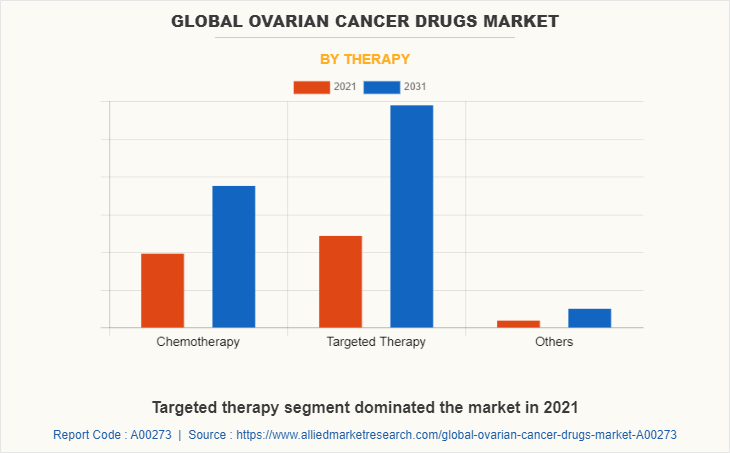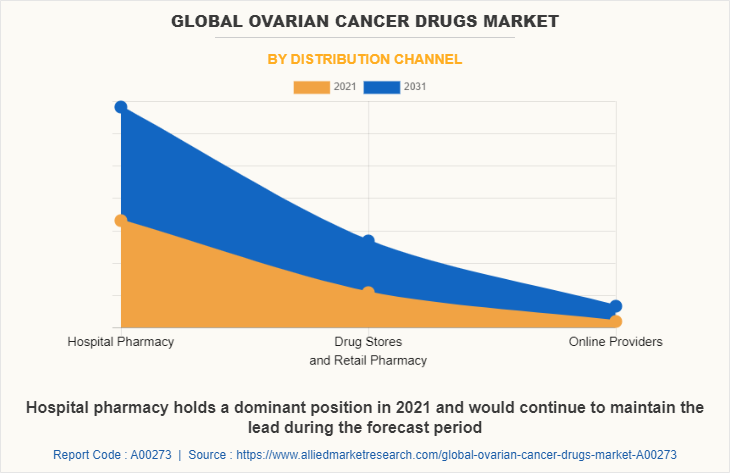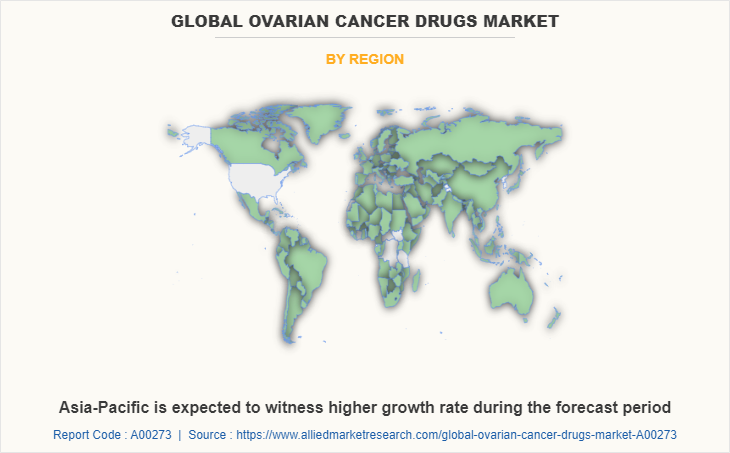Ovarian Cancer Drugs Market Research, 2031
The global ovarian cancer drugs market size was valued at $2.3 billion in 2021 and is projected to reach $5.1 billion by 2031, growing at a CAGR of 8.4% from 2022 to 2031. The market was analyzed qualitatively and quantitatively from 2018-2020. The ovarian cancer drugs market grew at a CAGR of around 4-6% during 2018-2021. Most of the growth during this period was derived from the Asia-Pacific owing to the improving health awareness, rising disposable incomes, as well as well-established presence of domestic companies in the region.

Market Introduction and Definition
Ovarian cancer is the most common cause of mortality for women with gynecological cancers Additionally, it ranks as the seventh most common cause of mortality for females overall. The majority of instances are discovered when the disease has already progressed, which leads to poor outcomes. The limited predictive value of the current screening tests adds to this anguish. The most common early detection methods, including a detailed gynecological examination, transvaginal ultrasound, and laboratory markers like the cancer antigen-125 (CA-125) assay, have not significantly reduced the morbidity or death of this malignancy. Surgery and platinum-based chemotherapy are the conventional forms of treatment, however during the past ten years, anti-angiogenic bevacizumab and poly (ADPribose) polymerase (PARP) inhibitors have gained popularity in the management of this gynecological cancer. A high rate of recurrence after the initial treatment has also been noted. The majority of these relapsed cases have a lower chance of recovery and are known to have a higher rate of treatment failures. Therefore, novel treatment methods based on a deeper understanding of the molecular characteristics of this malignancy are required now more than ever.
Key Market Dynamics
Growth & innovations in the pharmaceutical industry for the manufacturing of ovarian cancer drugs owing to massive pool of health-conscious consumers, creates an opportunity for the ovarian cancer drugs market. Rise in product approval of various ovarian cancer drugs by key players across the globe is set to affect the market growth positively. For instance, in November 2020, European Union (EU) approved lynparza treatment with bevacizumab for homologous recombination deficient positive advanced ovarian cancer. The growth of the ovarian cancer drugs market is expected to be driven by high potential in untapped, emerging markets, due to availability of improved healthcare infrastructure, increase in unmet healthcare needs, rise in prevalence of ovarian cancer, and surge in demand for ovarian cancer drugs.
The healthcare industry in emerging economies is developing at a significant rate, owing to rise in demand for enhanced healthcare services, significant investments by government to improve healthcare infrastructure, and development of the medical tourism industry in emerging countries. E-commerce (electronic commerce) has become a vital tool for small and large businesses globally, due to rise in preference of consumers for online shopping over traditional purchasing methods. This is attributed to further supports ovarian cancer drugs market growth. In addition, the surge in cancer awareness and early screening of cancer fuels the growth of the market. Increase in investment from the government, public and private sector further drive the growth of the market.
Rise in consumer awareness related to preventive healthcare and ease of accessibility boost the adoption of ovarian cancer drugs. Moreover, the market may grow as a result of the entry of new companies being encouraged by the patent expiration of numerous popular medications. The market is anticipated to grow during the forecast period as a result of these shifting dynamics. Additionally, improvement in patients’ quality of life by increasing survival and remission rates in patients suffering from ovarian cancer, breast cancer, and others. Moreover, rise in use of tamoxifen, aromatase inhibitors and PARP inhibitors for treating ovarian cancer has accelerated the growth of the cancer hormonal therapy segment.
However, the aim of developing and using cancer drugs is to kill the rapidly proliferating cells. The majority of chemotherapy drugs do not distinguish between cancerous and healthy cells. As a result, the action of chemotherapeutic drugs frequently causes the destruction of both healthy and malignant cells. The occurrence of multiple adverse effects makes treatment difficult, this in turn, hamper the growth of the market. Conversely, accelerated technological advancement in drug discovery technique and high investment by the government for drug development are expected to offer lucrative growth opportunities for the key players in the market.
Market Segmentation
The ovarian cancer drugs market size is segmented into therapy, distribution channel and region. By therapy, the market is categorized into chemotherapy, targeted therapy and others. Targeted therapy segment further bifurcated by drug class into PARP inhibitors, angiogenesis inhibitors and others, by distribution channel, the market is classified into hospital pharmacy, drug stores and retail pharmacy, and online providers. Region wise, the market is analyzed across North America, Europe, Asia-Pacific, and LAMEA.
By Therapy
based on therapy, the market is segmented into chemotherapy, targeted therapy and others. The targeted therapy segment dominated the global market in 2021, and is expected to remain dominant throughout the forecast period. This is attributed to the cancer cells can be marked with a specific targeted therapy, making it simpler for the immune system to recognize and eliminate them. In addition, some targeted therapies can help in enhancing the immune system so that it fights cancer effectively which further boost the market growth. Moreover, High investment by research companies for the development of biological targeted drugs along with increasing incidences of cancers such as breast cancer, gynecological cancer, ovarian cancer and among others are also drive the growth of targeted therapies for cancer treatment.

By Distribution Channel
the market is classified into hospital pharmacy, drug stores and retail pharmacy, and online providers. The hospital pharmacy held the largest ovarian cancer drugs market share in 2021, owing to increase in prevalence of ovarian cancer and increase in healthcare spending. In addition, hospital pharmacy is primarily responsible for monitoring the availability of all medications used in the hospital. The growth of the hospital pharmacy primarily attributable to the factor such as patient’s trust on hospitals as they have high-quality services and easy availability of medicines. In addition, increase in hospital admissions as ovarian cancer treatment are primarily performed in hospitals, which boost growth of this segment. Moreover, surge in number of hospital pharmacies and improvement in structure of hospital pharmacy in emerging countries such as China and India further fuel growth of the market.

By Region
The market is analyzed across North America, Europe, Asia-Pacific, and LAMEA. North America accounted for a major ovarian cancer drugs market share in 2021, and is expected to maintain its dominance during the forecast period.
Increased public awareness of the need of early cancer detection, the availability of cutting-edge therapies, and the development in the number of products receiving regulatory approval drive the growth of ovarian cancer drugs market. Furthermore, development of a number of new cancer medications as a result of the rapid advancements in the field of tumour biology, genetics, and immunology. Furthermore, presence of well-established healthcare infrastructure and high purchasing power are expected to drive the market growth. Furthermore, product launch, partnership, collaborations, and acquisitions adopted by the key players in this region boost the growth of the market. For instance, in September 2022, Pfizer and Strata Oncology have expanded their partnership for a clinical trial assessing various cancer therapies in new, biomarker-guided patient groups.
Asia-Pacific expected to grow at the highest rate during the ovarian cancer drugs market forecast. The market growth in this region is attributable to presence of pharmaceutical companies in the region as well as growth in the purchasing power of populated countries, such as China and India. Moreover, rise in personalized medicine expenditure and adoption of high-tech processing to improve the production of ovarian cancer drugs, drive the growth of the market. In addition, high population base, presence of unmet medical needs, and increase in disposable incomes of people in the region further boost the market growth. Moreover, rise in medical tourism and developing healthcare infrastructure make Asia-Pacific a lucrative market for ovarian cancer drugs. Furthermore, increase in technological innovations in drug discovery, surge in funding provided by the government and private organizations, presence of large number of healthcare reforms, and increase in aging population of woman drive the growth of the market. Moreover, increase in demand for advanced healthcare services in emerging economies such as India and China are the major factors that drive the growth of the Asia-Pacific market. Asia-Pacific offers profitable opportunities for key players operating in the ovarian cancer drugs market, thereby registering the fastest growth rate during the forecast period, owing to the growing infrastructure of industries, rising disposable incomes, as well as well-established presence of domestic companies in the region. In addition, rise in contract manufacturing organizations within the region provides great opportunity for new entrants in this region.

Competitive Landscape
Competitive analysis and profiles of the major players in the ovarian cancer drugs industry, such as Abbvie, Pfizer, Inc., Merck Kagan, AstraZeneca, F. Hoffmann-La Roche AG, Johnson & Johnson Services, Inc., GlaxoSmithKline Plc, Boehringer Ingelheim International GmbH, Clovis Oncology, Amgen. are provided in this report. There are some important players in the market such as AstraZeneca, F. Hoffmann-La Roche AG and others. Major players have adopted product approval and partnership as key developmental strategies to improve the product portfolio of the ovarian cancer drugs market.
Recent Key Strategies and Development
- In September 2022, AstraZeneca and Merck announced that Lynparza (olaparib) has been approved in China for the maintenance treatment of adult patients with advanced epithelial ovarian, fallopian tube, or primary peritoneal cancer who are in complete or partial response to 1st-line platinum-based chemotherapy in combination with bevacizumab and whose cancer is associated with homologous recombination deficiency (HRD)-positive status.
- In September 2022, Pfizer and Strata Oncology have expanded their partnership for a clinical trial assessing various cancer therapies in new, biomarker-guided patient groups.
Key Benefits for Stakeholders
- This report provides a quantitative analysis of the market segments, current trends, estimations, and dynamics of the ovarian cancer drugs market analysis from 2021 to 2031 to identify the prevailing global ovarian cancer drugs market opportunity.
- The market research is offered along with information related to key drivers, restraints, and opportunities in ovarian cancer drugs industry.
- Porter's five forces analysis highlights the potency of buyers and suppliers to enable stakeholders make profit-oriented business decisions and strengthen their supplier-buyer network.
- In-depth analysis of the global ovarian cancer drugs market segmentation assists to determine the prevailing market opportunities.
- Major countries in each region are mapped according to their revenue contribution to the global market.
- Market player positioning facilitates benchmarking and provides a clear understanding of the present position of the market players.
- The report includes the analysis of the regional as well as global global ovarian cancer drugs market trends, key players, market segments, application areas, and market growth strategies.
Global Ovarian Cancer Drugs Market Report Highlights
| Aspects | Details |
| Market Size By 2031 | USD 5.1 billion |
| Growth Rate | CAGR of 8.4% |
| Forecast period | 2021 - 2031 |
| Report Pages | 189 |
| By Therapy |
|
| By Distribution Channel |
|
| By Region |
|
| Key Market Players | Boehringer Ingelheim International GmbH, Pfizer, Inc., AstraZeneca, GlaxoSmithKline plc, Merck KGaA, Amgen Inc., Johnson & Johnson Services, Inc., Clovis Oncology, Abbvie Inc, F. Hoffmann-La Roche AG |
Analyst Review
This section provides various opinions of the top-level CXOs in the ovarian cancer drugs industry. In accordance with several interviews conducted, the utilization of ovarian cancer drugs is expected to witness a significant rise owing to increase in prevalence of ovarian cancer in both developed and developing economies.
Furthermore, the global ovarian cancer drugs market growth is propelled by surge in aging population of woman, increase in collaboration between pharmaceutical companies for development of novel cancer drugs, and rise in awareness associated with early detection of ovarian cancer among populace.
North America accounted for the highest market share in 2021, due to availability of advance ovarian cancer drugs, higher ovarian cancer awareness, and heavy expenditure by the government on healthcare, followed by Europe. Asia-Pacific is expected to exhibit fastest market growth due to increase in incidence of ovarian cancer and constant focus of pharmaceutical companies on expanding their presence in emerging economies, which is anticipated to drive the market growth.
The key trends in the ovarian cancer drugs Market are increase in aging population of women, rise in the prevalence of ovarian cancer, launch of innovative medications, boost in healthcare expenditure, and higher government support
The forecast period in the report is from 2022 to 2031
North America is the largest regional market for Global Ovarian Cancer Drugs
The market value of ovarian cancer drugs market in 2021 was $2283.8 million
The top companies that hold major market share in the ovarian cancer drugs market are AbbVie, Pfizer, Inc., Merck Kagan, AstraZeneca, F. Hoffmann-La Roche AG, and Johnson & Johnson Services, Inc.
Loading Table Of Content...



